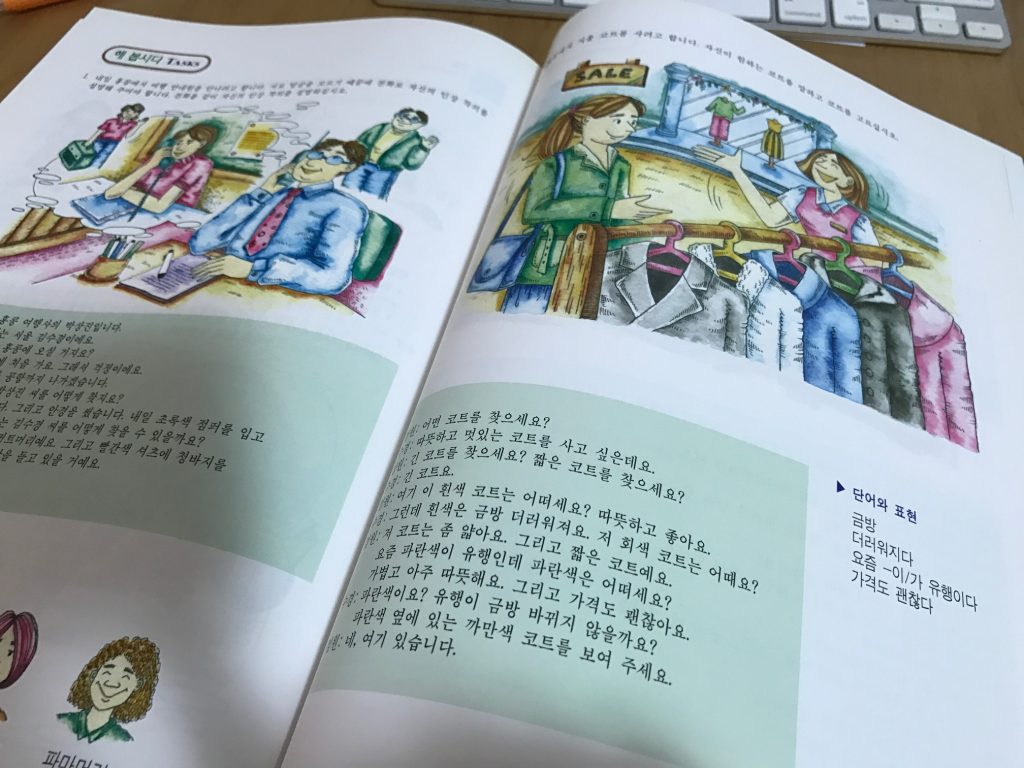Many Korean learners would be familiar with the Ewha textbook series, but have anyone seen this one? It’s an old textbook published by Ewha in 1998 and they had a second edition published in 2009 (which is what I’m holding on to).

Textbooks back in those days are quite different (and rather limited choices too). Some of the things I observed are (1) tendency to have minimal English explanations; (2) focus on classroom activities; (3) use of technical linguistic terms; (4) minimal grammar explanations (I assume that’s because it’s designed for classroom use and the teacher should do the explanations?); and (5) a tougher curriculum.
The fifth point is harder to pinpoint and explain. It feels like textbooks these days are more well-structured and you can see that new grammar / learning points are introduced gradually to avoid overwhelming the learner. But in older textbooks, sometimes you see new (difficult) stuff being thrown in out of nowhere with minimal explanations, even for beginner textbooks.
Introduction of Hangeul

While I appreciate that they use IPA to explain the sounds, I found it hard to follow the system (to think I did linguistics in uni…) and the technical explanations. For someone who is self-studying from this book, the language could seem overwhelming.

The chapters cover quite good ground in beginner Korean, although sometimes I question the order and structure of the book. I was quite surprised to see numbers being introduced in the first chapter (first item in fact), probably because I am used to books introducing them in chapter 3 or so instead.

As the book is designed for classroom use, there’s a lot of activities and classroom-based tasks with minimal explanations, which would leave the self-learner feeling very confused. Because of that, I find myself skipping a lot of stuff and only looked at dialogues or reading passages. It’s also very interesting how there isn’t any grammar explanations at all in the book….It’s really like a show-not-tell kind of book, where they give you examples of how it’s used and then you can figure it by yourself. Ok, this book is probably meant for classroom use so I can’t fault it.
Oh. Besides the introduction of Hangeul chapter, everything else is in Korean. So again, not quite friendly to self-learners.

Overall, I thought the book was just not very suitable for self studying and rather behind the times given that many recent textbooks for classroom use are also more comprehensive. Yet, I will not say it’s a bad one, given that it’s pretty challenging as a beginner textbook (passages are of substantial length) and would be quite a nice complement to a main textbook (such as the current Ewha textbook series).
What I like:
- Challenging for a beginning textbook
- Great graphics and quite interesting content
- Something different from the usual textbooks
What can be improved:
- Lack of grammar explanations
- Structure can be a little haphazard and the pace a little overwhelming
- Not that suitable for self learners, focus on classroom activities and tasks
To purchase, you can follow this Amazon link.


3 Comments
Korean learner
13 March, 2017 at 12:37 AMGiven the abundance of good textbooks in the market, why use or even review an old series? Any review of Fun Fun Korean and Sogang series is welcome.
Hangukdrama
18 March, 2017 at 9:06 PMhaha old series could be good also 🙂 Will review the Sogang books next time!
Teo
17 May, 2017 at 2:07 AMHope to see your unbiased review of sogang and fun fun korean (korea university) since you have already nicely reviewed snu, ewha, yonsei and easy korean (easy korean academy).